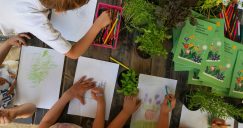Settings for regenerative learning
Learning Ecosystems

- Article, Educational resource, Research
Drawing inspiration from the realm of evolutionary biology, specifically Bronfenbrenner’s 1979 work, the notion of learning ecosystems offers a departure from the conventional belief that education rests solely on the shoulders of individual entities such as schools.
Instead, it posits that schools are integral components of more intricate systems, where interconnected relationships unfold among various entities—such as families, communities, non-formal learning organisations, and schools. Different entities within this educational ecosystem assume distinct roles in relation to individual learners, and these roles evolve over time.
Similar to how an ecosystem relies on its surroundings, broader influences like national educational policies can also impact the learning ecosystem. Every individual is situated within a unique learning ecosystem that shapes their lifelong learning journey in diverse ways. In the context of STEM education, for instance, a young person might encounter STEM through family visits to museums, develop an interest in engineering through meaningful projects at a youth club, consume STEM-related media during leisure time, or engage in climate activism through local voluntary organisations.
The nature of a student’s learning ecosystem can vary significantly depending on geographic location, as well as their own family situation, their social and cultural norms, and their science capital (Archer et al., 2015).
A learning ecosystem, as implied by its name, constitutes a network or system comprising individuals and organisations connected through symbiotic relationships based on shared interests, technology, resources, skills, and tools. A learning ecosystem as an intentional collaborative network aims to innovate and co-create opportunities that enhance learning within their communities. Key to learning ecosystems is the inclusion of “non-traditional” learners and educators, whose expertise plays a pivotal role in crafting new learning solutions and pathways for community-based, lifelong learning. Each individual within the community serves as a node in this network, possessing unique knowledge, skills, and experiences. As these experiences transform into learning opportunities for others, they foster and consolidate connections within the community.
Learning ecosystems could encompass various elements, including after-school programs, science centres, galleries, museums, libraries, archives and other cultural and creative institutions, as well as informal social or home-based experiences. These converge to offer a rich tapestry of learning opportunities. While some learning pathways may evolve organically, others can be deliberately designed and organised with the explicit goal of empowering learners to acquire competencies in specific disciplines – this is demonstrated in the case of the STEM ecosystems throughout the United States and worldwide participating in the STEM Learning Ecosystems Network.

Sample STEM Learning Ecosystem.
Just as the environments in which learning ecosystems are diverse and varied, so too are the stakeholders who engage with it. Stakeholders are those individuals or groups who have an interest in the development and results of the learning ecosystem. The ways in which those interests manifest and the ways in which the stakeholders engage with the learning ecosystem are multitudinous. Stakeholders can refer to those groups or individuals who collaborate in the design and construction of the ecosystem; they can provide funds or other material resources; but they are also the learners, learning providers, and community members within which the learning ecosystem is embedded.
Within learning ecosystems, playlists or pathways can be useful way to conceptualize the learning journey. A learning pathway represents a route taken by a learner in which they engage with the learning opportunities offered by the community and progressively build upon these experiences in order to gain knowledge and skills. They differ from traditional, formal education curricula by focusing on a specific learning goal, skill acquisition, or industry experience. Learning pathways offer a more curated approach, that are designed to engage the specific learner in a more natural and integrated learning experience and are often intended to help communities address specific problems and challenges. A successful Learning Ecosystem will co-create the learning pathways with the community and maintain a shared responsibility for learning outcomes. The community cannot be treated as a passive recipient of knowledge but instead must act as an active collaborator and the hub around which the spokes of learning, wellbeing, and developmental outcomes are arranged and supported. Sensitive and mutually productive engagement of both the learning providers and the learners within a community is at the heart of successful Learning Ecosystems.
Within the LEVERS project, the Learning Venture acts as drivers for a local learning ecosystem, and the members work with the community to ensure continuity across the various learning settings, so that the climate action projects undertaken by learners in various educational and community organisations have a level of coherence and continuity, and learning can be celebrated through common achievements towards a shared climate and environmental justice goal that is meaningful within the locality.
Resource
The WISE Learning Ecosystems Living Lab is an initiative of the Qatar Foundation, which promotes a place-based and collective design approach to mobilse practitioners, experts, policymakers and innovators as a global community of practice and thought-leadership that will support the design of key components of Learning Ecosystems in different regional contexts. Their website contains a useful set of articles by global leaders such as the series “Bringing Learning Ecosystems to Life: What does it take?“
In 2022, the WISE Learning Ecosystems Living Lab published a playbook entitled “Designing Learning Ecosystems” to provide readers with tools to plan and work on practical steps to create learning ecosystems within their own communities and contexts. This playbook is a foundational resource for the LEVERS project, and can be accessed here.








